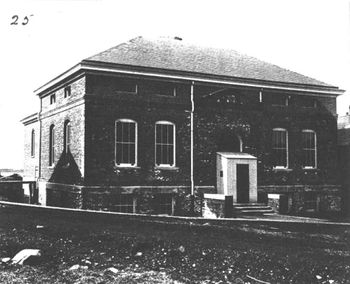Fort Andrews (1)
| More information at Warlike, Wikidata, Wikipedia
Fort Andrews (1) (1897-1948) - An Endicott Period Coastal Fort first established in 1897 as a sub-post of Fort Strong (2) on Peddock's Island, Plymouth County, Massachusetts. Named Fort Andrews in G.O. 43, 4 Apr 1900, after Major General George Lennard Andrews (Cullum 1454), professor of languages, United States Military Academy, 1871-1892, who served throughout the U.S. Civil War (1861-1865), and was brevetted major general of volunteers for faithful and meritorious service. Declared surplus in 1947 and abandoned in 1948.
Endicott Period (1890-1910)Part of the Harbor Defense of Boston, Massachusetts. Five Endicott Period gun batteries were built between 1898 and 1904 on Fort Andrews. The first battery to be built, Battery Whitman, was accepted for service on 15 Jan 1902. The remaining four batteries, Battery Cushing, Battery Bumpus, Battery Rice and Battery McCook (2), were all accepted for service on the same day, 29 Dec 1904. During much of this period, Fort Andrews was a sub-post of Fort Strong. General Order 135, 8 Aug 1904, made Fort Andrews an independent post, no longer a sub-post of Fort Strong. Battery Whitman was remodeled during the 1909-1913 time frame and four of its mortars and carriages were shipped to Fort Mills, Battery Geary in the Philippines on 17 Dec 1910. The four mortars and carriages were replaced in 1913 with the newer M1908 mortars and carriages. Construction on the permanent post buildings began in 1904-1905 and continued until 1912. By the end of 1912, the post was essentially complete. Fort Andrews was built out as a four-company, open plan, coastal fort. Officer and NCO quarters were arranged in a semicircle at the base of a hill facing four 109-man enlisted barracks buildings across a narrow parade. The gun batteries were placed on the north end of the island, behind and to the west of the four barracks.

World War I (1917-1918)In 1917 the guns of Battery McCook (2) and Battery Rice were ordered dismounted and prepared for service abroad. In 1918, two mortars from Battery Whitman and four mortars from Battery Cushing were dismounted and shipped away. The guns from Battery McCook (2) were remounted in 1920 but the mortars were not remounted and Battery Rice remained unarmed. The post was built up during the war with temporary WWI buildings, some of which can still be seen on the 1921 fort plan. By 1938, these temporary buildings were gone and the permanent buildings are listed as being in poor to good shape. One of the permanent 109-man barracks (bldg. 13) was rendered unusable by a serious fire In 1933 and it was not replaced. World War II (1941-1945) The two mortar batteries, Battery Cushing and Battery Whitman, were obsolete at the beginning of World War II and they were both ordered scrapped by the end of 1942. Battery McCook (2) and Battery Bumpus remained active throughout the war, Battery McCook (2) was improved, increasing the size of its gun platforms. No new gun batteries were added during World War II. On 30 Jun 1940, the capacity of Fort Andrews was listed at 12 Officers, 13 NCOs, and 329 enlisted men. A significant building program was put in place over the next year so that on 30 Jun 1941 there were twelve new temporary 63-man barracks, five mess halls, and numerous new support buildings all in anticipation of a coming war. The capacity of the post was raised from 329 to 1085 enlisted men and that number was later supplemented by many additional tents and hutment quarters. During the war, Fort Andrews was also used to house Italian POWs. These POWs were members of one of the Italian Service Units (ISUs). These units were instituted after the surrender of Italy as a part of the Axis, and were made up of soldiers who had been investigated for any "fascist tendencies" and had taken an oath of allegiance to the United States. The Boston unit troops were used to load and unload cargo at the Port of Embarcation in Boston and worked 9 hrs. per day for $.09 an hour. They were ferried back and forth from Peddocks Island to the Port of Boston each day. Prior to being transferred to Ft. Andrews, these Italian troops had been housed at Camp McKay, a series of temporary buildings near what is now Columbia Point in South Boston (near Carson Beach). Friction between South Boston residents and the ISU troops led to several incidents of violence, so in June 1944 about 1100 Italians were moved out to Fort Andrews. They continued working at the port until the end of the war and were often hosted by Italian families from the North End during furloughs from the Fort Andrews campsite.
Cold War (1947-1991)The post was declared surplus in 1947 and abandoned in 1948. On 22 Nov 1957, the Island was sold to private investors in preparation for transfer to recreational use. Current StatusPart of Boston Harbor Islands National Recreation Area and Boston Harbor Islands State Park, Peddock's Island, Plymouth County, Massachusetts.
Sources:
Links: Visited: No | |||||||||||||||||||||||||||||||||||||||||||||||||||||||||||||||||||||||||||||||||||||||||||||||||||||||||||||||||||||||||||||||||||||
- Not Visited
- All
- Massachusetts All
- Massachusetts Forts
- Massachusetts Plymouth County
- Coastal Forts
- Harbor Defense of Boston
- Fort Andrews (1)
- Preserved
- National Recreation Area
- Endicott Period Forts
- World War I Forts
- World War I Coastal Forts
- World War II Forts
- World War II Coastal Forts
- Starter Page
- Massachusetts Not Visited


